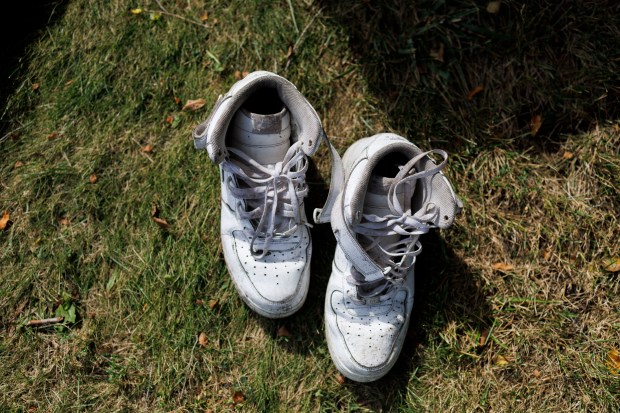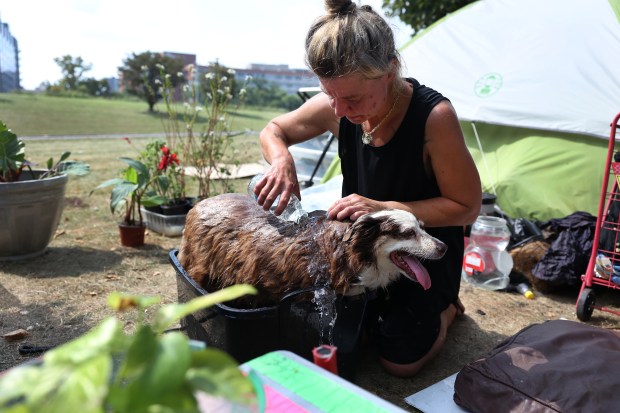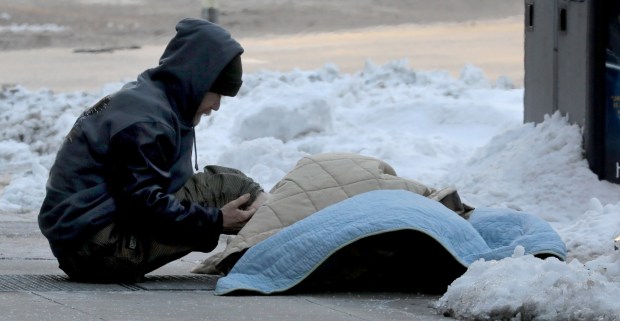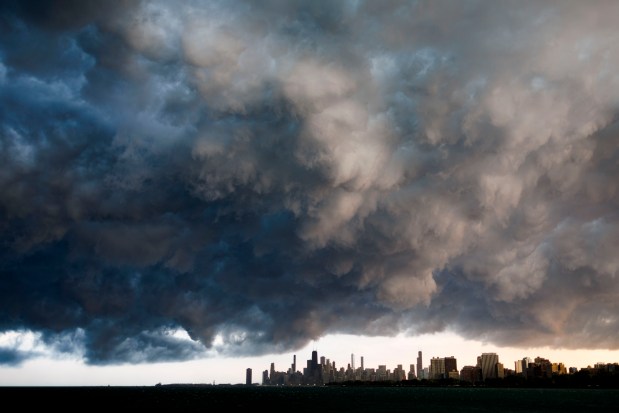Tamala Wilson has spent the past two and a half months living on a grassy stretch of land along Marine Drive in Uptown. She arranges flowers to decorate her tent. She makes her bed. She stores ice and food in a cooler. And she runs her own emergency weather drills to prepare for summer storms.
So on Tuesday, as a heat wave reached its peak with temperatures in the high 90s, Wilson was already bracing herself for the thunderstorms expected that evening.
“Since I’ve been out here, I’ve been doing nothing but trying to practice, just in case something happens,” Wilson said. “If there’s a tornado, you don’t stay in your tent. You run towards that bridge, you run for shelter inside something that’s concrete. … I got a hard hat. You try to make sure that you have a bag you can run with.”
Advocates don’t think Wilson should be preparing on her own. They say the city of Chicago does not have a sufficient extreme weather plan for those experiencing street homelessness.
As city officials themselves admit, there is no guaranteed 24/7 refuge center for the unhoused in Chicago during the most extreme weather events.
A coalition of service agencies are pressing the city to reform its plan before the winter comes again, arguing that the health and safety risks to Chicago’s unhoused population during days of extreme cold, heat and storms are too pressing to be ignored. Every winter, between 20 and 60 people living on the streets of Chicago freeze to death, according to Doug Fraser, executive director of the Chicago Help Initiative.
“At the end of the day, this is people’s lives, this is our city, our neighbors that need to be taken care of,” said Morgan McLuckie, CEO of the Orange Tent Project, which provides insulated tents to Chicago’s homeless population during the winter.
On days of extreme heat or cold, the city activates cooling or warming centers for the public depending on whether a certain temperature threshold has been reached. These centers are established in repurposed public spaces, including community centers, libraries, senior centers, academic buildings and park field houses.
However, activists argue that these spaces are not equipped to fit the needs of a vulnerable population during extreme weather. All but one of them close after regular business hours, and none provide overnight shelter, leaving unhoused individuals on the streets for the coldest nights of the winter if shelter beds are full.
The problem of street homelessness in Chicago has become front and center in recent years. The arrival of tens of thousands of migrants since 2022 has put increased pressure on the shelter system and contributed to the city’s unhoused population, which in January was estimated to be over 18,800. Meanwhile, the city has demolished multiple tent encampments this summer, as the legality of street homelessness itself has been thrown into flux by the U.S. Supreme Court.
As human-caused climate change leads to more days of unpredictable and extreme weather, including heat waves, blizzards, tornadoes and severe storms, advocates say they fear the effects on Chicago’s homeless population will be catastrophic if an adequate solution is not found soon.
“More people are going to suffer,” said Qi Charles Zhang, chief medical officer of Chicago Street Medicine. “It’s important that we all really work together and get our heads together, because it’s coming, it’s here, and it’s just going to get worse.”
Gaps in the system
During three heat waves that hit Chicago this summer, Monica Dillon, a retired nurse who works with Northwest Side Homeless Outreach Volunteers, said she visited cooling centers to make sure they were adequate places to send her overheated clients.
She said she knocked on the door of a locked-up church listed on the city’s website as a cooling center. Once she found the site supervisor, he said he didn’t know anything about it, she said. Another church identified as a cooling center on a sweltering Saturday in June told her later that they had in fact been closed that entire day, she recalled to the Tribune.
“I checked out a number of the field houses that were listed, and several of the field houses had no air conditioning, and only one was wheelchair accessible,” Dillon said. “I was really shocked by that.”

Other activists recounted similar stories.
Asked for comment, the city’s Department of Family and Support Services did not directly respond to the allegations.
“We’ve operationalized expanding cooling center sites, hours and days while providing more consistent and accurate information to press and those needing access to cooling centers,” department spokesperson Brian Berg wrote in an email to the Tribune. “We are continuing to assess available resources and coordinating across departments to look for every possible additional opportunity to expand opportunities and resources to keep residents safe and warm in the winter.”
Activists argue that the city’s messaging regarding the availability of its cooling and heating centers has been inconsistent and misleading for those seeking shelter.
“(The centers) are pretty much only open from 9 to 5, and then not all of the centers that are actually advertised as being open are actually open,” said Theresa Nguyen, emergency physician and medical director of Loyola Street Medicine. “Oftentimes, if we’re discharging a patient from the (emergency division) or even from the hospital, and we’re telling them to go to these places, it’s almost like we’re setting them up for failure.”
Even for the centers that are open and temperature-controlled, barriers to access still persist.
Cooling and warming centers are not distributed evenly throughout the city, said Chicago Street Medicine President Timothy Jostrand. Those who need the centers most may lack reliable transportation or have mobility issues, he said.
Wilson said Tuesday that she doubted anyone from her Uptown encampment would consider leaving their belongings behind to go to a cooling center due to the risk of theft. “You’re gone for any amount of time, and they know they’ll go in and take what they want,” she said.
State Rep. Lindsey LaPointe, a Democrat from the city’s Northwest Side who worked in homeless outreach prior to taking office, added that notification is often last-minute regarding when and where cooling or warming centers will be open.

“People that are vulnerable, especially people that are living unsheltered, are not easy to find and get information to,” LaPointe said. “When we don’t have clear, consistent and in-advance communication, it becomes very difficult for people to connect with the lifesaving resources.”
Yet all advocates interviewed said that by far the greatest issue in the city’s current emergency weather response plan is the lack of 24/7 coverage.
All but one of the city-run cooling and warming centers are only open Monday through Friday, 9 a.m. to 5 p.m.
The Garfield Community Service Center at 10 S. Kedzie Ave. is the only location technically open 24/7. However, these extended hours are only for connecting individuals to emergency shelter placement, according to a DFSS spokesperson. The center still shuts its doors for heating and cooling services soon after nightfall, sending unhoused people back out onto the streets if no shelter beds are available, Dillon said.
“There really isn’t a place to go in the middle of the night, in the dead of winter, that will let you stay,” said attorney Marc Raifman, an extreme weather planning advocate.
The only options left for people seeking refuge from the weather during the nighttime hours are police stations.
Yet the availability of these stations for warming or cooling is not being communicated to those in need, advocates said. Indeed, the overnight sheltering capacity of police stations is not mentioned on the city’s websites and flyers about extreme weather relief options.
As another winter approaches, the stakes of this lack of overnight options will only increase, many said.
“The fact that (warming centers are) only open during the daytime really doesn’t solve the problem of when patients are most at risk, which is at night,” Nguyen said.
Berg said DFSS plans to issue a request for proposal during the winter months to increase shelter bed capacity during extreme weather emergencies, as they did last winter.
During the winter in Chicago, temperatures regularly fall below freezing, accompanied by heavy snowfall during winter storms. This January, the wind chill — how a cold temperature feels to the human body — plummeted to minus 30 degrees. Such conditions can cause frostbite on exposed skin within 10 to 30 minutes, according to the National Weather Service.
Joanna Kondracki-Miro, who lives in a tent near DuSable Lake Shore Drive in Uptown, said Tuesday that although the heat wave was “brutal,” she still far preferred summers to winters.
“Heatstroke is always a worry in this weather, but the cold is terrible too,” Kondracki-Miro said. “Unless you get donations in the winter of kerosene or propane, and have a way to heat, it’s hard getting food. And my tents are messed up, like, zippers don’t close.”

Those interviewed emphasized that an immediate lifesaving change the city can make for this winter is keeping some warming centers open 24/7. And they’re pushing to make sure that happens.
A coalition of advocates and health care providers submitted a list of recommendations to the city on Aug. 1, detailing critical barriers to warming and cooling access as well as a potential emergency weather response plan.
They hoped to discuss this proposal in City Council this fall. In July, Ald. Andre Vasquez, 40th, had submitted a resolution calling for a subject hearing on extreme weather, which was approved.
Vasquez said Friday that conversations regarding the logistics of the subject matter hearing are still underway. He said that no date is set yet, but that the hearing could even take place as late as the first quarter of 2025. Advocates have said that even an October meeting would be far too late.
“It’s winter. It’s not that you don’t know it’s coming,” Fraser said. “We’re going to end up in the same pickle that we got in last time, which is, it’s going to be cold, people are going to be on the CTA in every darn Blue Line car. They’re going to be sleeping in the airports, they’re going to be jamming up emergency rooms — all kinds of things that needn’t happen if we plan ahead.”
Mitigating the dangers of extreme weather
People experiencing street homelessness disproportionately live with chronic health conditions, facing malnutrition and psychological stress, said Zhang, who treats such patients with Chicago Street Medicine. These factors all intensify the risks to the human body posed by extreme heat and cold, he said.
“Even when the weather is super nice, even on a great spring day, they live in a state of constant stress,” Zhang said. “Existing without the basic necessities of human life, and constant danger, constantly not knowing whatever it is, it not only takes a mental toll, but it takes a toll on the body.”
In September 2023, a survey of people experiencing street homelessness by the Chicago Homelessness and Health Response Group for Equity found that 46% of individuals surveyed said that they were living with a diagnosed chronic health condition.
And 35% said they had experienced a “serious weather-related injury or illness,” including frostbite, hypothermia or heatstroke.
During the hottest days of the summer, unhoused people without respite from the heat can face severe dehydration and exacerbate existing heart problems, Zhang said.
In the winter, frostbite often leads to amputations of digits and limbs among Chicago’s homeless population. Walking around in wet shoes and socks in cold temperatures can lead to a cold-related injury known as “trench foot,” prevalent among World War I soldiers and yet now reappearing on the streets of Chicago, according to Zhang.

Even when these injuries are treated, they rarely fully heal before people have to return to the streets, Zhang said. He recalled one of his homeless patients whom he treated for mild frostbite on all of his digits. A year later, he saw the same man and realized that all of his fingers had been amputated.
“There’s only so much that our teams, our attending residents, our volunteers can do on the street to mitigate the effects of extreme weather,” Jostrand said. “You really got to get people off the street and into temperature-controlled environments in order to really counter the effects.”
Overall, advocates say that cooling and warming centers are only a temporary solution to larger systemic problems, emphasizing the need for more shelter beds and long-term pathways out of homelessness.
Given the threats of more extreme weather in coming years due to climate change, Fraser said that the city needs to take decisive action now, as “it’s a predictable crisis coming.”
“It just points to the perennial need for more permanent housing so no one is homeless to begin with,” said Doug Schenkelberg, executive director of the Chicago Coalition to End Homelessness, “and we don’t have to worry about how extreme weather is impacting people living on the streets, because they aren’t there.”




